Posté par Marine Schütz, le 21 février 2013;
- Date et lieu du colloque : 14 et 15 mars, Tate Modern, Londres
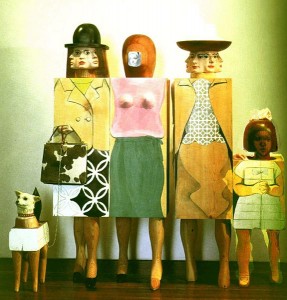 Global Pop Symposium Global Pop Symposium
Tate Modern, Starr Auditorium Thursday 14 March, 10.15 – 17.40 and Friday 15 March 2013, 10.30 – 17.45
£20/ £14 This price is for a one-day ticket. A two-day discount is available (£24 / £16 concessions). To book a two-day ticket please call 020 7887 8888.
This two-day symposium explores Pop beyond the mainstream. Organised in collaboration with the Royal College of Art, London, this event engages with new research in different fields and geographies to rethink orthodoxies as well as develop new interpretations of ‘Pop’.
Of particular importance is the often critical nature of these global engagements with Pop. Reacting to the increasing dominance of the . . . → En lire plus
Posté par Damien Bril, le 18 février 2013;
- Date limite : 1er mars 2013
- Date et lieu du colloque : 18-20 avril 2013, Zagreb
Zagreb, Croatia, April 18 – 20, 2013 Deadline-CFP: 1 mars 2013
Call for Papers for the Panel: Identities and the Cities: Urban Transformations, Transition and Change in Urban Image Construction
(As part of the Euroacademia International Conference ‘Identities and Identifications’, Zagreb, 18 – 20 April 2013)
Panel Organizers: Tihana Puc and Ivana Nakikj, IMT Institute for Advanced Studies, Lucca, Italy
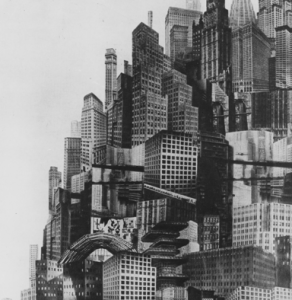 Elasticity of the label identity accommodates everything that does and does not surround us, thus finding its place in every discourse on making and re-making, invention and re-invention, destruction and construction. Every transition is synonymous with said processes, be it a tectonic change or a peaceful shift. As political systems and . . . → En lire plus Elasticity of the label identity accommodates everything that does and does not surround us, thus finding its place in every discourse on making and re-making, invention and re-invention, destruction and construction. Every transition is synonymous with said processes, be it a tectonic change or a peaceful shift. As political systems and . . . → En lire plus
Posté par Damien Bril, le 4 février 2013;
- Date limite : 11 mars 2013
- Date et lieu du colloque : 2 mai 2013, Dartmouth
Made in the USA: The History and Legacy of Cold War Art & Design (2nd Annual Undergraduate Art History Conference at UMass Dartmouth)
UMass Dartmouth, May 02, 2013 Deadline-CFP: 11 mars 2013
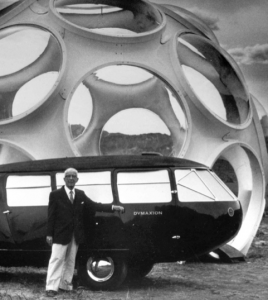 Showcased at the 1959 American national exhibition in Moscow, the work of American designers Buckminster Fuller, Charles&Ray Eames, and George Nelson, among others, epitomized the power and prestige of the USA at the height of the Cold War. Meanwhile, the art of Jackson Pollock and other Abstract Expressionists were being utilized as ideological weapons through the traveling exhibitions of the Marshall plan. Showcased at the 1959 American national exhibition in Moscow, the work of American designers Buckminster Fuller, Charles&Ray Eames, and George Nelson, among others, epitomized the power and prestige of the USA at the height of the Cold War. Meanwhile, the art of Jackson Pollock and other Abstract Expressionists were being utilized as ideological weapons through the traveling exhibitions of the Marshall plan.
It is also in this context that Brutalism was born. Utilizing raw concrete and linear and . . . → En lire plus
Posté par Olivier Bonfait, le 1 février 2013;
- Date limite : 20 mars 2013, 20 mars 2013
Appel à projet ANR : Métamorphoses des sociétés
« Emergences et évolutions des cultures et des phénomènes culturels », (CULT).
Date de clôture : 20 mars 2013.
Le PROGRAMME METAMORPHOSES DES SOCIETES
Dans un environnement marqué à la fois par de nouvelles formes d’échange, d’interdépendance et de différenciation entre les cultures et par certaines formes de globalisation des modes de vie et de pensée, l’étude des sociétés et des cultures dans leurs transformations et dans leur invariance prend une actualité particulière. La compréhension des phénomènes en jeu, qu’ils se situent sur les plans politique, social, économique ou culturel, nécessite une mise en perspective historique, l’étude des processus aux différentes échelles, l’analyse de la pluralité des contextes et celle des perceptions que les individus, les . . . → En lire plus
Posté par Damien Bril, le 24 janvier 2013;
- Date limite : 28 janvier 2013
- Date et lieu du colloque : 26 avril 2013, New Brunswick
Call for Abstracts: Networks
Art History Graduate Student Symposium Rutgers, The State University of New Jersey April 26, 2013 Deadline-CFP: 28 janv. 2013
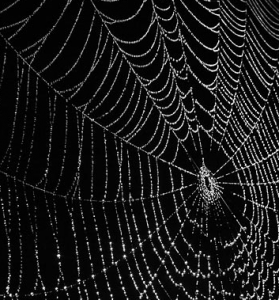 “A culture may be conceived as a network of beliefs and purposes in which any string in the net pulls and is pulled by the others, thus perpetually changing the configuration of the whole.” – Jacques Barzun “A culture may be conceived as a network of beliefs and purposes in which any string in the net pulls and is pulled by the others, thus perpetually changing the configuration of the whole.” – Jacques Barzun
What constitutes a network and how do networks operate across time and space? How have social, cultural, and artistic networks been defined and functioned historically? How has the global turn reconfigured such networks? How have networks been embedded in art history and art practice across time?
The Art History Graduate Student . . . → En lire plus
Posté par Damien Bril, le 17 janvier 2013;
- Date limite : 25 janvier 2013
- Date et lieu du colloque : 15-16 mars 2013, Prague
The European Way – Identitarian Representations of Europe in Visual Arts, Performing Arts and Literature
Prague, Czech Republic, March 15 – 16, 2013 Deadline-CFP: 25 janv. 2013
As part of the Third Euroacademia Global Conference ‘Europe Inside-Out. Europe and Europeaness Exposed to Plural Observers’ to be held at Grand Majestic Plaza in Prague, Czech Republic  In contemporary Europe some of the main indicators of the lack of a unitary identity come from the deficit of symbols, images, artistic representations or literary writings that would pin-point towards a unity of sensibility and of artistic perception. Europe appears through visual representations as a divided continent coming from an extremely diverse universe of imaginary . . . → En lire plus In contemporary Europe some of the main indicators of the lack of a unitary identity come from the deficit of symbols, images, artistic representations or literary writings that would pin-point towards a unity of sensibility and of artistic perception. Europe appears through visual representations as a divided continent coming from an extremely diverse universe of imaginary . . . → En lire plus
Posté par Damien Bril, le 16 janvier 2013;
- Date limite : 8 février 2013
- Date et lieu du colloque : 17-20 juillet 2013, Lisbonne
(Mis-)understanding religious art in colonial encounters (Panel 11)
Centro de História de Além-Mar (CHAM), Lisbon, Portugal.
July 17 – 20, 2013 Deadline-CFP: 8 févr. 2013
The Centro de História de Além-Mar (CHAM) opend the call for papers for the international conference « Colonial (Mis)understandings: Portugal and Europe in Global Perspective, 1450-1900, » 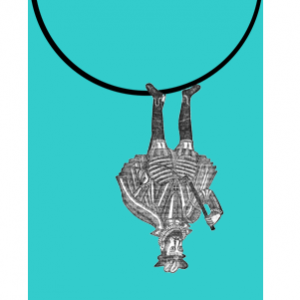 Art and images based upon Christian concepts were highly relevant to the global expansion of the Catholic Mission starting from the late 15th century onwards. Its objects and symbols served both as emblems of cultural identification and differentiation as well as media for communication and practice of the Christian belief. However, roaming via the global missionary and . . . → En lire plus Art and images based upon Christian concepts were highly relevant to the global expansion of the Catholic Mission starting from the late 15th century onwards. Its objects and symbols served both as emblems of cultural identification and differentiation as well as media for communication and practice of the Christian belief. However, roaming via the global missionary and . . . → En lire plus
Posté par Damien Bril, le 10 janvier 2013;
- Date limite : 28 février 2013
- Date et lieu du colloque : 26-27 septembre 2013, Munich
Visualizing Portuguese Power: The Political Use of Images in Portugal and Its Overseas Empire (16th to 18th Century)
München, Center for Advanced Studies, September 26 – 27, 2013 Deadline-CFP: 28 févr. 2013
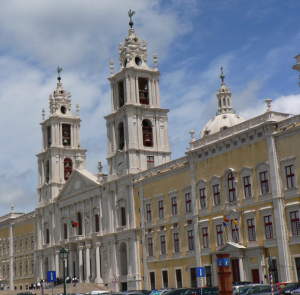 Images have always played a vital role in political communication and in the visualization of power structures and hierarchies. They gain even more importance in situations where non-verbal communication prevails: In the negotiation processes between two (or more) different cultures, the language of the visual is often thought of as the more effective way to acquaint (and overpower) the others with one’s own principles, beliefs, value systems. Scores of these asymmetrical exchange situations have taken place in . . . → En lire plus Images have always played a vital role in political communication and in the visualization of power structures and hierarchies. They gain even more importance in situations where non-verbal communication prevails: In the negotiation processes between two (or more) different cultures, the language of the visual is often thought of as the more effective way to acquaint (and overpower) the others with one’s own principles, beliefs, value systems. Scores of these asymmetrical exchange situations have taken place in . . . → En lire plus
Posté par Damien Bril, le 7 janvier 2013;
- Date limite : 15 janvier 2013
- Date et lieu du colloque : 18-19 octobre 2013, New York
Fashioning Identities: Types, Customs, and Dress in a Global Context A Symposium at Hunter College, City University of New York, October 18-19, 2013 Chairs: Lynda Klich and Tara Zanardi, Dept. of Art & Art History
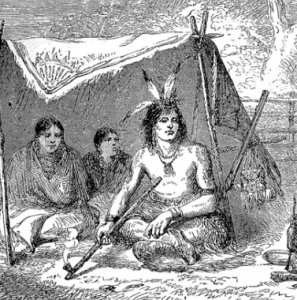 Pictorial imagery of local types, traditions, and dress has a long history, dating back to the sixteenth century. From costume books and street criers to travel albums and Hispanic costumbrismo, such representations captured people and daily life in a purportedly realistic manner, often emphasizing specificity over universal themes. Popular types, customs, and dress served as both sources of national pride and exotic spectacles of regional traditions. These depictions of local color often valued certain practices, regions, or . . . → En lire plus Pictorial imagery of local types, traditions, and dress has a long history, dating back to the sixteenth century. From costume books and street criers to travel albums and Hispanic costumbrismo, such representations captured people and daily life in a purportedly realistic manner, often emphasizing specificity over universal themes. Popular types, customs, and dress served as both sources of national pride and exotic spectacles of regional traditions. These depictions of local color often valued certain practices, regions, or . . . → En lire plus
Posté par Christian Omodeo, le 4 janvier 2013;
- Date et lieu du colloque : 17-20 janvier 2013, Paris
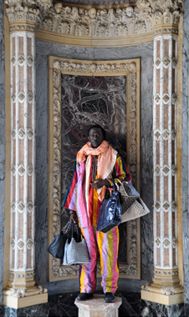 Paris, scène culturelle internationale incontournable, très influente en Occident tant sur le monde des arts que sur les notions de modernité, s’est avérée être le lieu idéal pour la conférence, « Black Portraiture(s) : La représentation du corps noir en Occident ». Cette conférence est la cinquième d’une série organisée depuis 2004 par Harvard University et New York University. Du XIXe siècle à nos jours, « Black Portraiture(s) » a pour objectif d’explorer les différents concepts de fabrication et outils d’auto-représentation ainsi que la notion d’échange à travers le regard, dans les domaines des arts plastiques et visuels, de la littérature, de la musique, de la mode et des archives. Comment sont exposées . . . → En lire plus Paris, scène culturelle internationale incontournable, très influente en Occident tant sur le monde des arts que sur les notions de modernité, s’est avérée être le lieu idéal pour la conférence, « Black Portraiture(s) : La représentation du corps noir en Occident ». Cette conférence est la cinquième d’une série organisée depuis 2004 par Harvard University et New York University. Du XIXe siècle à nos jours, « Black Portraiture(s) » a pour objectif d’explorer les différents concepts de fabrication et outils d’auto-représentation ainsi que la notion d’échange à travers le regard, dans les domaines des arts plastiques et visuels, de la littérature, de la musique, de la mode et des archives. Comment sont exposées . . . → En lire plus
Posté par Damien Bril, le 21 décembre 2012;
- Date limite : 1er février 2013
- Date et lieu du séminaire : 14 juin 2013, Londres
Liquidity – Practice Research Symposium
Middlesex University London, June 14, 2013
 This one-day practice research symposium sets out to explore the many articulations, explorations, and manifestations of ‘liquidity’ in contemporary visual and material culture, history and theory. The symposium offers a unique opportunity for practitioners, researchers and scholars working across different fields to engage with any topic related to ‘liquidity’ broadly conceived. This one-day practice research symposium sets out to explore the many articulations, explorations, and manifestations of ‘liquidity’ in contemporary visual and material culture, history and theory. The symposium offers a unique opportunity for practitioners, researchers and scholars working across different fields to engage with any topic related to ‘liquidity’ broadly conceived.
‘Liquid modern life is a daily rehearsal of universal transience. Today’s useful and indispensable objects, with few and possibly no exceptions, are tomorrow’s waste. Everything is disposable, nothing is truly necessary, nothing is irreplaceable. Everything is born engraved with the brand of death. Everything is offered with a use-by . . . → En lire plus
Posté par Damien Bril, le 14 décembre 2012;
- Date et lieu du colloque : 5-7 septembre 2013, Londres
- Date limite : 1er février 2013
MATERIALIZING THE SPIRIT: SPACES, OBJECTS AND ART IN THE CULTURES OF WOMEN RELIGIOUS
Institute of Historical Research, Senate House, London, September 5 – 07, 2013 Deadline-CFP: 1 févr. 2013
The History of Women Religious of Britain and Ireland Annual Conference will be hosted by the Institute of Historical Research, University of London, on 5-7 September 2013.
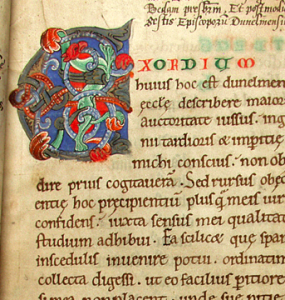 Paper proposals are now invited. Presentations should be 20 minutes in duration, and should address some element of the conference theme, with reference to British and/or Irish contexts. The devotional and vocational activities of women religious sculpted the physical space of religious houses in unique ways. Patterns of use were etched into the fabric of . . . → En lire plus Paper proposals are now invited. Presentations should be 20 minutes in duration, and should address some element of the conference theme, with reference to British and/or Irish contexts. The devotional and vocational activities of women religious sculpted the physical space of religious houses in unique ways. Patterns of use were etched into the fabric of . . . → En lire plus
Posté par Matthieu Lett, le 2 décembre 2012;
- Date et lieu de la journée d'étude : 6-7 décembre 2012, Musée des arts forains et Bibliothèque nationale de France (salle des Commissions)
Journées d’études co-organisées par l’Institut national d’histoire de l’art et le département des Arts du spectacle de la Bibliothèque nationale de France.
Dans le cadre et avec le soutien du Labex ARTS-H2H et en partenariat avec l’Institut international de la marionnette.
Comité scientifique : Thierry Dufrêne (INHA), Raphaèle Fleury (IIM) et Joël Huthwohl (BnF)
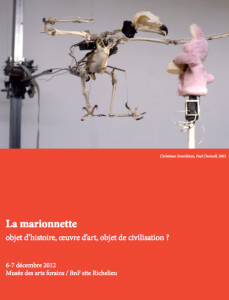 La marionnette est un objet intermédiaire. Longtemps située à la croisée des domaines de l’artisanat d’art, des pratiques religieuses, de la culture populaire et de la virtuosité du mouvement, elle a connu une nouvelle naissance et suscité de nouvelles perceptions en se confrontant au théâtre et à l’art contemporains, à la . . . → En lire plus La marionnette est un objet intermédiaire. Longtemps située à la croisée des domaines de l’artisanat d’art, des pratiques religieuses, de la culture populaire et de la virtuosité du mouvement, elle a connu une nouvelle naissance et suscité de nouvelles perceptions en se confrontant au théâtre et à l’art contemporains, à la . . . → En lire plus
Posté par Matthieu Lett, le 2 décembre 2012;
- Date et lieu du colloque : 13-14 décembre 2012, Petit Palais (Auditorium), avenue Winston Churchill, Paris, France (75008)
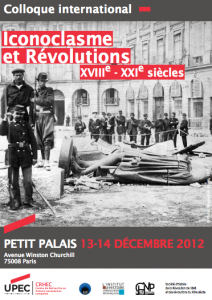 Statues déboulonnées, portraits déchirés ou brûlés, emblèmes grattés ou barbouillés : ces gestes iconoclastes semblent indissociables des processus révolutionnaires, des révolutions atlantiques du XVIIIe siècle aux révolutions arabes contemporaines. Que se joue-t-il derrière ces gestes apparemment dérisoires, souvent ravalés à du « vandalisme » ? Comment penser, à partir de l’iconoclasme, une histoire des relations entre des sujets et des signes de pouvoir (politique, religieux, social) ? Tel sera l’objet de ce colloque international et pluridisciplinaire, qui réunira au Petit Palais historiens, historiens de l’art, anthropologues, spécialistes d’aires culturelles et de périodes différentes, de la France à l’Afghanistan, de la Chine à l’Amérique latine, de la Russie à . . . → En lire plus Statues déboulonnées, portraits déchirés ou brûlés, emblèmes grattés ou barbouillés : ces gestes iconoclastes semblent indissociables des processus révolutionnaires, des révolutions atlantiques du XVIIIe siècle aux révolutions arabes contemporaines. Que se joue-t-il derrière ces gestes apparemment dérisoires, souvent ravalés à du « vandalisme » ? Comment penser, à partir de l’iconoclasme, une histoire des relations entre des sujets et des signes de pouvoir (politique, religieux, social) ? Tel sera l’objet de ce colloque international et pluridisciplinaire, qui réunira au Petit Palais historiens, historiens de l’art, anthropologues, spécialistes d’aires culturelles et de périodes différentes, de la France à l’Afghanistan, de la Chine à l’Amérique latine, de la Russie à . . . → En lire plus
Posté par Réka Krasznai, le 2 décembre 2012;
- Date et lieu du colloque : 6-7 décembre 2012, Paris, Galeries nationales du Grand Palais, auditorium, entrée Square Jean Perrin (avenue du Général Eisenhower)
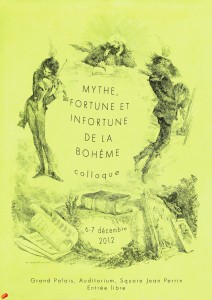 Le colloque Mythe, fortune et infortune de la bohème, préparé à l’occasion de l’exposition Bohèmes (Galeries nationales du Grand Palais, 26 septembre 2012-14 janvier 2013), en prolonge les mises en relations inédites entre les deux acceptions du mot, et les questions posées à propos du concept de bohème artistique qui s’est forgé au milieu du XIXe siècle, entre romantisme et réalisme, avant de donner lieu à maintes réinterprétations. Le terme cristallise un ensemble de transformations du statut de l’artiste qui s’opèrent alors. A travers la littérature et la presse, la bohème, évocatrice de liberté, d’errance, mais aussi de misère et de marginalité, acquiert très vite une popularité immense ; elle . . . → En lire plus Le colloque Mythe, fortune et infortune de la bohème, préparé à l’occasion de l’exposition Bohèmes (Galeries nationales du Grand Palais, 26 septembre 2012-14 janvier 2013), en prolonge les mises en relations inédites entre les deux acceptions du mot, et les questions posées à propos du concept de bohème artistique qui s’est forgé au milieu du XIXe siècle, entre romantisme et réalisme, avant de donner lieu à maintes réinterprétations. Le terme cristallise un ensemble de transformations du statut de l’artiste qui s’opèrent alors. A travers la littérature et la presse, la bohème, évocatrice de liberté, d’errance, mais aussi de misère et de marginalité, acquiert très vite une popularité immense ; elle . . . → En lire plus
Posté par Marine Schütz, le 19 novembre 2012;
- Date de la journée d'étude : 28 et 29 juin 2013
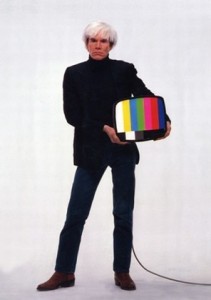 Appel à communication pour les journées d’étude « Du studio au plateau de télévision : appropriations, détournements et réinterprétations par les artistes » Appel à communication pour les journées d’étude « Du studio au plateau de télévision : appropriations, détournements et réinterprétations par les artistes »
les 28 et 29 Juin 2013
L’art vidéo puise son origine directement de la télévision. Un des premiers artistes à travailler avec la technologie vidéo, Nam June Paik disait que celle-ci « était la fille de la télévision ». Les artistes s’en sont d’abord pris au téléviseur lui-même avant de voir en la vidéo un nouveau médium à expérimenter. Les liens qu’entretiennent les artistes avec la télévision n’ont cessé de se développer depuis les années 1960 et ces deux journées d’étude seront l’occasion de rendre compte des différentes sortes . . . → En lire plus
Posté par Martin Szewczyk, le 19 novembre 2012;
- Date et lieu du colloque : 23 et 24 novembre 2012 - Paris, Maison de la Recherche, 28 rue Serpente ; Université Paris-Sorbonne (Paris-IV), Centre de Recherches égyptologiques de la Sorbonne (CRES), 1 rue Victor Cousin
 Les 23 et 24 novembre 2012 se tiendra à l’Université Paris-IV Sorbonne un colloque intitulé Décrire, imaginer, constuire l’espace : toponymie égyptienne de l’Antiquité au Moyen-Âge. Il s’inscrit dans le cadre du programme de recherche « Systèmes toponymiques en Égypte de l’Antiquité au Moyen Âge », développé par l’Institut français d’archéologie orientale du Caire en partenariat avec Paris-IV Sorbonne et comprendra deux sessions de conférences autour des thématiques suivantes : « Légendes onomastiques et imaginaire de l’espace », « Toponymie et description du paysage », ainsi qu’une table-ronde réunissant les participants au programme et un atelier de formation à destination des étudiants de master et doctorat. Les 23 et 24 novembre 2012 se tiendra à l’Université Paris-IV Sorbonne un colloque intitulé Décrire, imaginer, constuire l’espace : toponymie égyptienne de l’Antiquité au Moyen-Âge. Il s’inscrit dans le cadre du programme de recherche « Systèmes toponymiques en Égypte de l’Antiquité au Moyen Âge », développé par l’Institut français d’archéologie orientale du Caire en partenariat avec Paris-IV Sorbonne et comprendra deux sessions de conférences autour des thématiques suivantes : « Légendes onomastiques et imaginaire de l’espace », « Toponymie et description du paysage », ainsi qu’une table-ronde réunissant les participants au programme et un atelier de formation à destination des étudiants de master et doctorat.
Programme 23 novembre
Maison de la Recherche, 28 rue Serpente, 75006 Paris, salle D40
. . . → En lire plus
Posté par Isabelle Decobecq, le 18 novembre 2012;
- Date et lieu de la journée d'étude : 29 novembre 2012, Université Lille 3
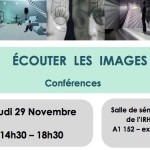 Cette demi-journée d’étude se situe dans le prolongement direct des initiatives récentes menées par l’IRHiS (Lille 3 – UMR 8529) dans le domaine émergent des visual studies. Clôturant les trois années d’existence du Réseau Thématique Pluridisciplinaire « Visual Studies. Les nouveaux paradigmes du visuel » (Lille 3 – CNRS), cette séance ouverte à tous sera l’occasion d’entendre trois conférenciers, appartenant à des champs disciplinaires différents, échanger sur leur pratique de l’image et des objets visuels. Cette demi-journée d’étude se situe dans le prolongement direct des initiatives récentes menées par l’IRHiS (Lille 3 – UMR 8529) dans le domaine émergent des visual studies. Clôturant les trois années d’existence du Réseau Thématique Pluridisciplinaire « Visual Studies. Les nouveaux paradigmes du visuel » (Lille 3 – CNRS), cette séance ouverte à tous sera l’occasion d’entendre trois conférenciers, appartenant à des champs disciplinaires différents, échanger sur leur pratique de l’image et des objets visuels.
Jeudi 29 Novembre 2012, 14h30 – 18h30, Université Lille 3.
Programme :
– Ralph Dekoninck (Université Catholique de Louvain) : Ce que les images disent ou ce que les images veulent ? Rhétorique, poétique et pragmatique de l’image durant la première modernité.
. . . → En lire plus
Posté par Damien Bril, le 15 novembre 2012;
- Date limite : 15 janvier 2013
- Date et lieu du colloque : 19-21 septembre 2013, Tokyo
Call for Papers : SEN On Lines and Non-Lines
International Conference Tokyo, 19 – 21 September 2013 Organized by Marzia Faietti and Gerhard Wolf, in collaboration with Shigetoshi Osano
Deadline-CFP: 15 janv. 2013
 « Sen » will be the third and last of a series of conferences that study the dynamics of lines in a dialogue of art historians, historians of science, philosophers and scholars of other disciplines. Lines and Non-Lines is conceived as a cross-cultural and transhistorical investigation, with a focus on past and present East Asian, Islamic and European concepts of linear and non-linear configurations of surfaces. It explores the borders and passages between drawing and writing, in regard to different scriptural and graphic cultures, as well . . . → En lire plus « Sen » will be the third and last of a series of conferences that study the dynamics of lines in a dialogue of art historians, historians of science, philosophers and scholars of other disciplines. Lines and Non-Lines is conceived as a cross-cultural and transhistorical investigation, with a focus on past and present East Asian, Islamic and European concepts of linear and non-linear configurations of surfaces. It explores the borders and passages between drawing and writing, in regard to different scriptural and graphic cultures, as well . . . → En lire plus
Posté par Gaetane Maes, le 11 novembre 2012;
- Date et lieu du colloque : 12-13 décembre 2012, Belgique, Leuven,KU, Faculty of Arts, Justus Lipsiuszaal
 The symposium aims to bring together national and international researchers in various historical disciplines to focus on a rare type of source material, namely documents that help to clarify the emotions of early modern artists from (primarily) the Low Countries (1580-1800). These sources are hard to find, but they are key to illuminating artists’ private concerns and the interpersonal relationships that existed within early modern artistic communities. The symposium aims to bring together national and international researchers in various historical disciplines to focus on a rare type of source material, namely documents that help to clarify the emotions of early modern artists from (primarily) the Low Countries (1580-1800). These sources are hard to find, but they are key to illuminating artists’ private concerns and the interpersonal relationships that existed within early modern artistic communities.
By combining archival research with the growing field of the study of early modern emotions, this symposium seeks to play a pioneering role in focusing on the emotional lives of artists. The presence of leading international authorities in the study of the history of . . . → En lire plus
|
Équipe Rédacteur en chef : Olivier Bonfait.
Rédacteurs : Elliot Adam (Moyen Age) ; Nicolas Ballet (XX-XXIe siècles) ; Matthieu Fantoni (musées) ; Antonella Fenech Kroke (bourses) ; Vladimir Nestorov (Lettre mensuelle)
Administrateur web : Matthieu Lett.
ancien éditeur : Pascale Dubus
anciens rédacteurs : Gautier Anceau, Sébastien Bontemps, Damien Bril ; Sébastien Chauffour ; Ludovic Jouvet ; Aude Prigot
|



















